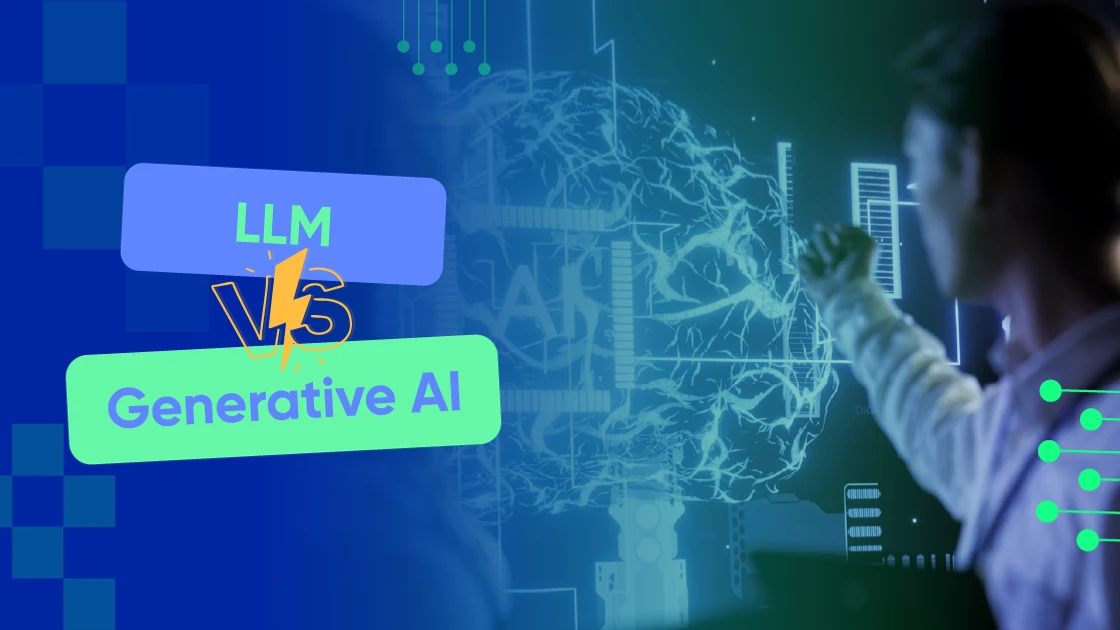If you are evaluating AI tools whether to build, buy or regulate, understanding LLM vs Generative AI in detail is essential.
Generative AI is a broad category that includes any system capable of creating new content. Large Language Models (LLMs), on the other hand, are a specialized subset of generative AI focused solely on language.
Why does this distinction matter? It directly impacts how your product behaves and how your engineering team integrates AI.
For example, Microsoft Copilot does not rely on a single LLM, it orchestrates multiple models and tools to deliver task-specific outputs across apps. That is not just generative AI, it is a composable, multimodal infrastructure.
This blog will explore generative AI vs LLM using real-world models to offer a clear framework for better engineering decisions.
What is a Large Language Model (LLM)?
A Large Language Model (LLM) is a type of artificial intelligence designed primarily to understand and generate human-like text. It’s trained on massive amounts of written data such as books, websites, and articles to learn how language works.
LLMs predict the next word or phrase in a sentence, similar to smart autocomplete, but with a much deeper understanding. They break text into small units called tokens and use a system called a transformer to understand how those tokens relate to each other.
While some advanced LLMs can now generate images or code, their core strength lies in processing and producing natural language. They form the backbone of many AI tools focused on writing, summarizing, translating, and answering questions.
Popular examples include ChatGPT, Gemini, and Microsoft Copilot.
What is Generative AI?
GenAI is a type of AI that can create new things such as text, images, music, or code based on what it has learned from existing data. It includes different types of models trained to generate outputs from learned patterns, such as image generators, audio synthesizers, and large language models (LLMs).
To understand its full potential, it is important to know its main goal to see how it drives innovation across industries.
LLMs, like ChatGPT and Gemini, are a specific kind of generative AI built to understand and produce human-like text. They are trained on massive datasets of written content and excel at tasks like answering questions, summarizing documents, and writing code.
In short, LLMs are one type of generative AI, but generative AI includes many other models that go beyond text to create rich, multi-format content.
LLM vs Generative AI: Core Technical Differences
Understanding the difference between LLM and generative AI requires a detailed look at their architecture and training objectives. Let’s decode it.
Architectural Scope
LLMs are built on the transformer architecture, introduced in the 2017 paper Attention Is All You Need. Transformers use self-attention mechanisms to weigh the relevance of each token in a sequence relative to others, enabling parallel processing and long-range dependency modeling.
This architecture replaced earlier RNNs and LSTMs due to its scalability and superior performance in NLP tasks.
Key Architectural Traits of LLMs
- Autoregressive or masked modeling: Autoregressive models predict the next token, whereas masked models predict missing tokens.
- Positional encoding: Injects sequence order into the model since transformers lack recurrence.
- Layer normalization and residual connections: Stabilize training and improve gradient flow.
Parameter scale: Modern LLMs range from hundreds of millions to trillions of parameters. GPT-3 has 175 billion; GPT-4 and Gemini are speculated to exceed 1 trillion.
Key Architectural Traits of Generative AI
- Diffusion models: These models are used in image generation that iteratively denoise random noise to produce coherent outputs.
- Generative adversarial networks: Consist of a generator and a discriminator in a zero-sum game. This is effective for high-fidelity image and video synthesis.
- Programmatic generators: Rule-based or template-driven systems used in code generation and structured content creation.
Multimodal pipelines: These systems interact with different AI agents that perform reasoning, decision-making, or task execution across various environments.
Training Objectives and Outputs
LLMs are Trained Using:
- Next-token prediction (GPT-style): Given a sequence, predict the next word.
- Masked language modeling (BERT-style): Predict missing tokens in a corrupted input.
- Instruction tuning: Fine-tunes models to follow human instructions using datasets.
Reinforcement learning from human feedback: Aligns model outputs with human preferences using reward models.
Generative AI Models Vary by Modality:
- Text: Works like LLMs, predicts the next word or fills in missing words.
- Images: Learns to create pictures by fixing noisy pixels or using two models.
- Audio: Builds sound by guessing wave shapes or turning visual sound maps into audio.
- Video: Predicts smooth transitions between frames while keeping motion and timing consistent.
Generative AI vs LLM: Deployment and Product Differences
The difference between generative AI and LLM directly impact how AI systems are built, hosted, and optimized for performance. Next, we will break down access models, cost-efficiency and scaling strategies across LLMs and generative AI deployments.
Access Models
- Hosted APIs like ChatGPT and Gemini Pro are ready-to-use tools that run on someone else’s servers. Means they are fast to plug in and suitable for testing ideas or building software-as-a-service (SaaS) products.
- Open-source models like LLaMA 2, Mistral, and Falcon give you full control. You can change how they work and run them on your own machines.
- Running models on your own servers (on-premises) is important for industries like healthcare and finance. It ensures your sensitive data is safe and remains within your own network.
As these systems become easier to deploy, it also raises critical questions about the responsibility of developers using them especially around data handling, transparency, and ethical use.
Latency and Cost Tradeoffs
- Model size directly impacts inference cost and latency. A 7B parameter model may run efficiently on a single GPU, while a 65B model requires multi-GPU orchestration and higher memory bandwidth.
Cost estimation depends on these parameters: token throughput (tokens/sec), batch size and concurrency, hardware type (A100 vs T4 vs CPU) and precision level (FP32 vs INT8).
Scaling Considerations
- Batching: Aggregates multiple requests to reduce per-token compute overhead.
- Quantization: Converts model weights to lower precision (e.g., INT8) to reduce memory footprint and accelerate inference.
- Distillation: Trains smaller models to mimic larger ones, preserving performance while reducing size.
Vector databases: Enable LLMs to access external knowledge for context-rich responses, an approach used in Captain Chatbot to deliver accurate and timely answers without extra overhead.
Practical Use Cases of LLM vs Generative AI
LLM and Generative AI may overlap in capability but their design choices shape very different strengths. Aligning the right model with the right problem is what separates experimentation from scalable impact. Let us understand use cases of each.
What Generative AI is Good for?
- Making images for ads, websites, or social media.
- Creating music or voices for videos or games.
- Generating videos like short clips or animated explainers.
- Building code for apps or websites.
Mixing formats like combining text, images, and voice in one tool.
What LLMs are Good for?
- Answering questions and chatting with users.
- Writing content like blogs, emails, or reports.
- Summarizing documents or pulling out key points.
- Helping with code by suggesting or fixing it.
Translating languages and adjusting tone or style.
Final Thoughts
Learning about LLM vs Generative AI gives you the “what” but making it work gives you the “how.” That’s where Squareboat comes in to help you bridge that gap by building custom AI systems or providing AI engineers through a staff augmentation model who can join your team and accelerate development.
If you have the vision, we have the team, so build the right way for real results.
Frequently Asked Questions
Q. Is Generative AI the same as an LLM?
No, generative AI includes models that create content across formats such as text, images, audio, video, and code. LLMs are a subset focused on language tasks, built on transformer architectures and trained for next-token or masked token prediction using large-scale text datasets.
Q. Is ChatGPT Generative AI or an LLM?
ChatGPT is powered by an LLM, optimized for natural language tasks. However, when integrated with tools, plugins, or multimodal inputs, it functions as part of a generative AI system. Its core model remains language-based, but its deployment may include broader generative capabilities.
Q. Can LLMs Generate images or videos?
Some advanced LLMs support multimodal outputs by integrating with image or video models. However, they are not natively designed for pixel-level generation. Tasks like image synthesis rely on diffusion models or GANs, which are better suited for visual content creation than LLMs.
Q. Can Generative AI models be trained without transformers?
Yes, genAI can use other types of models like GANs or diffusion models. These are often used to create images, sounds, or videos. So, generative AI is not limited to transformers, it depends on what kind of content the model is built to generate.
Q. What makes a model multimodal vs just generative?
A multimodal model can handle more than one type of input like text, images, and sound at the same time. A generative model might only work with one format. Multimodal models are designed to combine and understand different types of data.
Q. How do LLMs handle context windows and memory?
LLMs can only look at a limited amount of text at once, called a context window. If the input is too long, they forget earlier parts. To fix this, systems use tools like memory databases or retrieval methods to help the model remember and stay accurate.
Q. What is the difference between instruction tuning and prompt engineering?
Instruction tuning teaches the model to follow commands by retraining it with examples. Prompt engineering, on the other hand, gives smarter input to guide its response. Tuning changes the model’s behavior long-term whereas prompting adjusts it in the moment.


